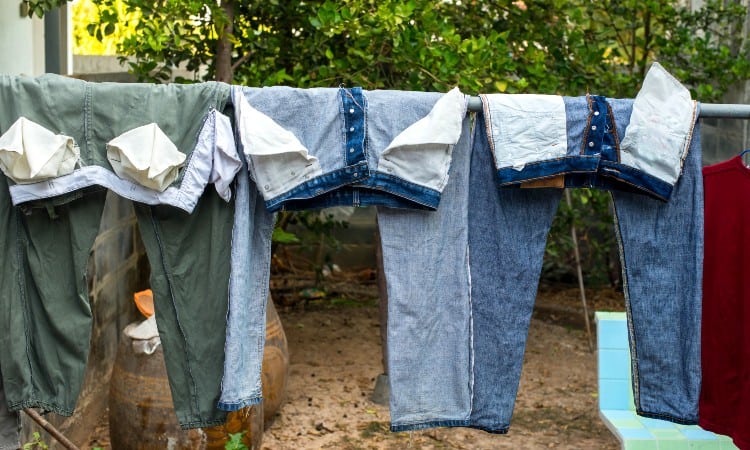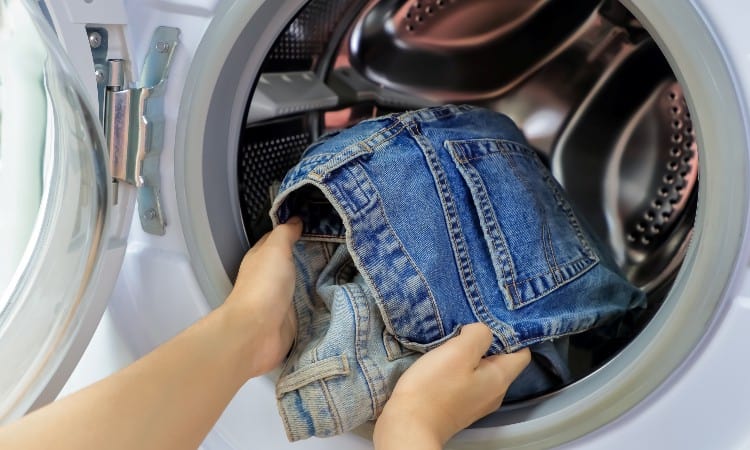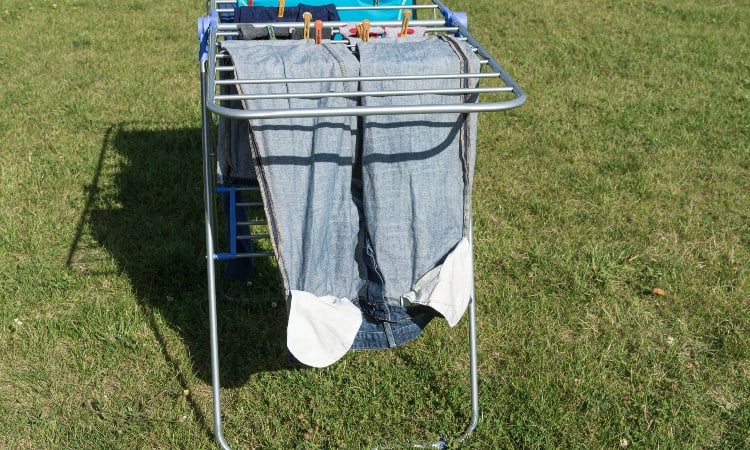Drying jeans always worries me. Especially new jeans. They seem to shrink as soon as you look at them. Can I prevent my jeans from shrinking? Is there a way to dry them safely? How do I dry my jeans?
Jeans should be air-dried. Turn them inside out and hang them on a clothesline from the waistband. This makes the drying process more even and reduces the risk of stiffness. They can also be dried flat. Drying jeans in a dryer can cause shrinkage. Always keep the heat low and remove the jeans while they are damp.
In this article, you’ll find out how to dry jeans without shrinking them. You’ll also discover how to keep them soft and comfortable without using a dryer.

Can You Dry Jeans?
Yes, you can dry jeans. Although you’d be forgiven for thinking jeans are impossible to dry due to the time they can take, especially if your jeans are made from heavyweight denim.
Jeans come in a range of styles, weights, and fabrics. Traditionally, they would have been 100% cotton woven into the famous denim twill weave. That’s no longer the case.
While you can still get jeans made from 100% cotton denim weighing around 16oz, you’re more likely to find your denim is a cotton blend. Being a blend makes the fabric lighter. You’re looking at between 5 and 12 oz, particularly if your jeans are made from a blend of cotton and lycra.
Modern denim blends are great news for drying times. Lighter fabrics with even a slight hint of synthetic content will dry faster than 100% cotton.
Of course, how you dry your jeans will also make a difference. Air drying wet jeans is the safest method to use. It’s also the most time-consuming. The quickest way to dry jeans is in the dryer.
However, dryers and jeans don’t always play nicely together. The heat from the dryer will speed up the drying process, but you might find your jeans will shrink.
How to Dry Jeans

The best way to dry your jeans is naturally. Jeans are made from cotton. Even the ones with synthetic fibers like elastane have a certain amount of cotton content. Cotton is notorious for shrinking, especially when subjected to heat. This is one of the reasons jeans are likely to shrink if you dry them in a dryer.
To dry your denim safely and to prevent damage to the garment, jeans manufacturers recommend air drying your favorite denim pants. They should know! Jeans have been around since the Californian Gold Rush in the 1800s, so they have had plenty of time to test and fine-tune care instructions for keeping denim in tip-top condition.
You will need:
- Your wet denim jeans
- Flat surface
- Skirt hanger
- External clothesline and clothespegs
Step 1
Remove your jeans from your washing machine as soon as the cycle has completed. They should be inside out. If they aren’t, turn them inside out before the next step. Keeping the inside of the jeans facing outwards helps protect the denim fibers and the color of the jeans.
Step 2
Drying indoors – Lay your jeans out on a flat surface. Reshape them so that the waistband and hems are straight and not crumpled. If you don’t have a flat surface, you can fold your jeans over an internal clothes rack. Just make sure to rearrange the jeans every so often, so they don’t dry with fold lines.
Hanging your jeans from a shower rail with a skirt hanger is a good way to ensure they dry straight and crease-free. Always hang from the waistband, as this will help hide any marks left by the hanger.
Drying outdoors – Peg your jeans to an external clothesline from the waistband. Position the pegs or clothespins on the back of the waistband. Don’t double up your denim and try to peg both the front and back to the clothesline. The front of your jeans needs to hang loose.
The pegs should be evenly spaced so there is one close to each side seam and one at the center back of your jeans. This distributes the weight and holds your jeans open. Leave the zipper and button undone.
Make sure the pegs hold the waistband to the clothesline. Do not fold the waistband over the line. You want the waistband to lay flat against the line. If your jeans slip away from the clothesline, use extra pegs.
You should never peg your jeans to the clothesline by the legs. Not only will you get peg marks and unsightly fold lines at the hem, but you will also hinder the drying process. Air will not be able to get to the inside of the jeans because gravity will hold them closed. This can add hours to the time it takes to dry your jeans.
How Long Do Jeans Take to dry?
The length of time it can take jeans to dry can vary. There are a couple of factors to consider when it comes to drying jeans, which can impact drying times.
Most jeans can take a few hours to a couple of days to dry completely. Let’s take a look at some of the reasons why jeans can take a while to dry.
Your Jeans
A factor that is often overlooked is the actual jeans. They aren’t all made the same or from the same fabric. Some are 100% cotton. Others are made from stretch denim containing synthetic fibers.
The difference in fiber content will affect the weight of the denim in the jeans. Heavier denim is more likely to have more cotton in it. Cotton absorbs moisture and stays wet for a long time. So if your jeans have a high cotton content, they will take longer to dry.
Even the cut of your denim jeans will make a difference to the drying time. Skinny jeans, for instance, aren’t just made from cotton denim blended with lycra. They are also cut smaller. The stretch allows them to be cut with something known as negative ease. This means they don’t have as much fabric as a regular-cut pair of jeans.
Similarly, cropped jeans cover less of your legs and have a smaller surface area than other styles, particularly if they are skinny and cropped. If you compare them with a pair of bootcut jeans or flared jeans, the difference in the amount of fabric can be quite considerable. More fabric equals longer drying times.
Atmospheric Conditions
Where you live and your usual weather patterns can make a big difference to the length of time it takes your jeans to dry. Different areas of the globe can vary immensely in moisture levels, heat levels, and even the strength of the breeze.
Drying jeans happens through evaporation. The moisture is sucked out of the fabric by the atmosphere and lifted skyward. This process can happen incredibly quickly or slowly depending on where you are.
Areas that have a high humidity level are already saturated with moisture. There’s only so much water the surrounding air can take. Think how you feel when you try drinking 8 glasses of water. You feel bloated, right? Well, the atmosphere can feel like that too! So it slows down the evaporation process.
Getting water out of your denim in this climate will likely take a little longer than in a dryer part of the world. Deserts are areas where water is scarce. Dry your jeans in the Sahara, and they are likely to dry in no time.
Where You Dry Your Jeans
When it comes to drying your jeans, you have two options. The one you choose will alter when it takes your jeans to dry. You can either dry them naturally or use a dryer.
Dryers aren’t recommended for jeans, but they reduce drying time. Instead of taking a couple of hours, your jeans can be dry enough to wear in around 45 minutes to an hour.
The actual time depends on the jeans you are drying. But, suffice it to say, dryers are the quickest way to get your jeans from sodden to wearable. It just isn’t the safest way to get them there.
Letting your jeans dry naturally is a better option, but it takes longer than a dryer. Rather than a quick tumble in a nice warm drum, the time it takes your jeans to dry is down to where you hang them.
If you dry your jeans indoors, the drying time will depend on the warmth inside your home. On colder days, when you have the heating on, your jeans are likely to dry faster. When it’s warm outside, but your jeans are inside, they are probably going to dry slower. Simply because they aren’t in the sunlight.
Drying your jeans outside on a clothesline will be faster than drying them indoors, especially if it’s a warm sunny day with a slight breeze. However, a cold day will more than double your drying time. Instead of a couple of hours, you’re looking at all day.
Can You Put Jeans in the Dryer?

Yes, you can put your jeans in the dryer. But you need to be very careful. You’ll need to watch both the heat and the time they are in there for.
Dryers can get hot and too much heat is bad news for wet jeans. It’ll dry the fibers out too quickly and cause your jeans to shrink. That’s one of the reasons why some jeans manufacturers recommend you stay away from your dryer when you need to dry jeans.
Another reason is the fiber content in the denim. If your jeans contain spandex, even the slightest amount, you should keep them out of the dryer! Spandex is easily damaged by heat. Your skinny jeans will lose their elasticity. So always air dry stretch denim!
For non-stretchy jeans, avoiding the dryer isn’t always possible. Especially if you’re pushed for time. When only your jeans will do and they are still wet, your dryer is your only hope.
You will need:
- Your wet jeans
- Your dryer
- Dryer balls or clean tennis balls
- Skirt hanger
- External clothesline
Step 1
Before putting your jeans in the drum, check the care label to ensure they do not contain any lycra, spandex, or elastane. Next, turn them inside out. Make sure the dryer is on its coolest setting.
Step 2
Put your jeans in the drum with some dryer balls. You can use clean tennis balls if you want to. The balls will bounce around in the drum and keep the jeans moving. This will ensure they dry uniformly throughout.
Step 3
Set your dryer to the shortest time possible. No more than 15 to 20 minutes, depending on the thickness of your jeans. If your dryer doesn’t have a timer, then check on your jeans after 15 minutes to see how they are doing.
Step 4
Reset the dryer for another 10 minutes if your jeans are still soggy. If they are damp, remove them from the machine. This is important. You don’t want your jeans to dry completely in the dryer. They need to be damp when you take them out. That’s damp. Not moist.
Step 5
Give your jeans a shake and reshape them as necessary. Hang them from a skirt hanger and leave them to air dry. You can put the hanger on the back of a door or suspend it from your shower rail. Remember to hang the jeans from the waistband, not the legs.
You can also air dry your jeans outside on a clothesline. Again, your pegs need to be at the waistband. Don’t peg them by the hems or fold the legs over the line. You’ll get peg marks and fold lines.
How Do I Keep Jeans Soft When Air Drying?

There’s no doubt about it. Air drying your jeans can make them feel stiff and rough to the touch. This can give you a bit of a dilemma. Dryers can make jeans feel soft, but they aren’t recommended for drying jeans. So how can you keep your jeans soft when air-drying them?
It’s not as hard as you think. All you need to do is change the way you wash your denim. Although, to be honest, these tips will keep all your laundry soft, not just your jeans.
Laundry Detergent
The first thing you need to do is watch the amount of detergent you use. Denim fabric is usually 100% cotton or a cotton blend. As it’s a natural fiber, it absorbs liquids. Water mostly, but as detergent dissolves in water, cotton can absorb that too.
That’s where the problems start. Detergent in the cotton fibers can make them feel rough. Particularly if there is too much detergent in the wash water and it isn’t rinsed out properly. This can cause a build-up of soap residue leading to stiffness in the material.
Denim doesn’t like not having enough detergent, either. If you don’t use enough, your jeans won’t get clean. Instead, any dirt, debris, or even detergent from a previous wash will collect in the fibers and cause stiffness.
So when washing your denim, treat your jeans like they are Goldilocks. Don’t use too much detergent and don’t use too little. You need to get that detergent level just right. To do that, always check the dosage instructions on the detergent bottle.
Fabric Softener
It sounds weird, I know, but fabric softener can make your jeans feel stiff. Just like detergent, fabric softeners are liquid. This means the softening chemicals can get absorbed by the cotton content in your jeans.
Not only will this lead to a build-up of goop in the fibers of your favorite denim, but fabric softeners will also cause the material to degrade. Particularly if your jeans have any kind of synthetic content.
It may sound tempting to use fabric softener on your jeans to stop them from feeling rough, but it will make them feel worse. Instead of adding fabric softeners to your final rinse, head for the kitchen and grab your distilled white vinegar.
Adding ¼ cup of distilled white vinegar to your wash water will work wonders to soften your denim. As it’s acidic, the vinegar will cut through the soap scum building up in the fibers of your jeans.
Once the chemical residue from detergents and fabric softeners has been eliminated, your jeans will be able to dry properly and feel softer. Better still, vinegar is a natural stain remover, so your jeans will come out cleaner too!
Work With Your Washing Machine
Washing machines these days are automatic, so it’s easy to turn them on and leave them to do their job. They are a wash-and-go device allowing you to set and forget them.
The thing is, that isn’t always a good idea when you’re washing jeans. Your denim pants need a little more attention than that. That can be said of any denim garment and cotton-based apparel in general.
You need to keep an eye on the wash cycle to get your jeans out of the washer as soon as it stops. This is particularly important if you have used a high spin setting. The higher the spin, the more water is expelled, and the faster your jeans will air dry, right?
Well, no. Not really. High spin cycles remove a lot of water, that part’s true. But, taking out too much water too quickly will cause wrinkles and creases. These will set into the denim the longer your jeans are in the machine.
So, get to the machine as soon as the cycle ends. Take out your jeans or any other cotton item, and give that garment a good shake. Otherwise, those spin-induced crinkles are going to dry that way. Making your jeans as stiff as a board.
Emptying your washing machine in a timely manner is one way to keep your jeans soft when you air dry them. Another is to change your spin cycle. Instead of going for the maximum spin available, go for a lower setting. Try a delicate spin.
This option keeps your denim soft in two ways. The gentle spin is less damaging to the fibers in your denim, so they won’t get roughed up. Rough fibers tend to dry like cardboard. Also, more water in the denim fabric means the jeans will take longer to dry.
Air drying is all about drying naturally. The longer it takes, the more chance the fibers in the material have to soften up after the washing cycle. Instead of being forced out under extreme centrifugal force, moisture can evaporate slowly, leaving your jeans supple and soft.
Another key factor to ensure your jeans can stay soft when you air dry them is to avoid overfilling your washing machine. Too many garments in the drum will hinder the washing process. The detergent will get caught in the denim fibers and won’t get rinsed out properly. You’ll end up wearing stiff jeans.
Distilled White Vinegar
 Not only does distilled white vinegar removes stains and eat soap residue, but it also softens fabric fibers. It’s a powerful cleaning tool that can give you a double whammy of power against the forces that create stiff jeans.
Not only does distilled white vinegar removes stains and eat soap residue, but it also softens fabric fibers. It’s a powerful cleaning tool that can give you a double whammy of power against the forces that create stiff jeans.
You can add it to the wash water to boost extra cleaning power for your detergent. It will remove stains and kick leftover detergent to the curb. Or at least out of your denim fibers. Vinegar can also clear residual soap scum from your washing machine. Preventing any future soap build-up from giving you cardboard pants.
Add another ¼ cup of distilled white vinegar to the final rinse and it will act as a fabric softener. Only vinegar won’t coat your jeans with chemicals and make them stiff. It will smooth out the fibers gently and naturally. Working from within the cotton rather than just covering the surface.
When you air dry your jeans after using vinegar as a softener, they’ll dry soft and flexible. Without any trace of detergent left in them, they have a better chance of recovering from the rigors of the washing machine. Safe for both natural and synthetic fibers, vinegar is your secret weapon to keep your jeans super comfy.
Hang Your Jeans From The Waistband
You should always hang your jeans from the waistband when you air-dry them. This goes for any pants, regardless of the material they are made from. This is because hanging pants and jeans from the waist makes the air-drying process more efficient.
The waistband is the thickest part of your jeans. It’s going to hold the most water after washing. The top of your jeans also has pockets. These are also made from denim, giving you extra layers of wet fabric. This means the top of your jeans will take the longest to dry.
Hanging from the waist also allows the jeans to stay open. Peg the back of the waist to your clothesline and your jeans will fall open naturally, allowing air to get inside the jeans. This helps both the inside and outside of your waistband area dry uniformly.
Remember, the key to soft jeans when you air dry them is not letting them dry out too fast. You don’t want some parts drying quicker than others, either. This will end in stiff jeans.
Air drying is natural. For it to work effectively, you need to work with nature. Keep the waistband at the top and let gravity do its thing. It will pull moisture from the top downwards through the legs. Letting the top half, the thicker part, dry faster than the lighter leg area.
The extra water escaping into the lower half of your jeans will keep the legs damper for longer. So they don’t dry out too quickly and have a better chance of drying in unison with the top of your jeans.
Besides, drying your jeans by pegging them to the line by the legs does more than turn them into the cardboard. It causes them to over-dry. This can mean peg marks on your hemline. If you fold your legs over the line by the ankle, you’ll have an unsightly crease that will be visible to all. The only way to get rid of that is by ironing. Why would you want to iron jeans?
My Jeans Shrunk in the Dryer, What Do I Do?
First of all, don’t panic! You can fix this. One of the great things about jeans is you can unshrink them. Simply and quickly. All you need to do is to get them wet again.
You will need:
- Your jeans
- A bathtub
- Lukewarm water
- A warm sunny day or your heating on
Step 1
Head for your bathtub wearing your jeans. They will be a little tight, so you might be unable to put them on properly. But do the best you can. Fill your bathtub with enough lukewarm water for you to sit in and cover your jeans.
Step 2
Sit in your bath for an hour or until the water gets too cold for you. The warmth in the water will stretch the denim fibers and mold the jeans to your body.
Step 3
When you get out of the tub, leave your jeans on. It’s going to feel uncomfortable and cold. That’s why you need a warm sunny day or your heating on. Walk around in them until they have dried naturally. Try bending down and crouching from time to time too. This will supple up the denim fibers and stretch them back to size.
Should You Dry Jeans?
You should dry your jeans unless you want to walk around squelching indefinitely. Although that can be fun for a while, it can get real old quick, not to mention a bit chilly.
How you dry them is up to you. Air drying your jeans is the safest and best way. For both 100% cotton jeans and synthetic blends. It stops the jeans from drying out too quickly, which is better for denim fibers. There is less chance of damage and loss of structural integrity, meaning your jeans will last longer.
You can use a dryer if you need to. Although, it’s not recommended. Especially not for stretch denim. You should never use a dryer with your skinny jeans, as the heat will kill your spandex. Always check your fiber content if you decide to dry your jeans in your dryer.
Be careful with the heat setting and don’t leave your jeans in there to completely dry out. There is more chance of them shrinking if you do. Take them out while they are still damp and leave them to air dry the rest of the way.
Conclusion
Drying your jeans doesn’t have to be a recipe for stiff cardboard pants. You can dry them and keep them soft and supple at the same time. Air dry them inside out on a clothesline for best results. Always hang them from the waistband so they can dry out evenly.
You can dry them in a dryer. But keep the heat low and don’t dry them completely. Remove them while they are damp and finish drying them outside on a clothesline. Or use a skirt hanger suspended from your shower rail.
Has this article helped you cure the dreaded stiff jeans syndrome? Do you feel more confident about washing and drying your jeans? Let me know in the comments.